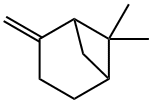| Identification | More | [Name]
beta-Pinene | [CAS]
127-91-3 | [Synonyms]
BETA-PINENE
BICYCLO [3.1.1] HEPTANE, 6,6-DIMETHYL-2-METHYLENE
B-PINENE
PINENE BETA
PINENE BETA R AND S
ROSEMAREL
2,2,6-Trimethylbicyclo(3.1.1)hept-2-ene
6,6-dimethyl-2-methylene-bicyclo(3.1.1)heptan
6,6-dimethyl-2-methylene-bicyclo[3.1.1]heptan
6,6-dimethyl-2-methylenebicyclo[3.1.1]heptane (beta-pinene)
beta-l-Pinene
l-beta-Pinene
Nopinen
Nopinene
Pseudopinen
Pseudopinene
terbenthene
Terebenthene
SS-PINENE
beta-Pinen | [EINECS(EC#)]
204-872-5 | [Molecular Formula]
C10H16 | [MDL Number]
MFCD00063635 | [Molecular Weight]
136.23 | [MOL File]
127-91-3.mol |
| Chemical Properties | Back Directory | [Appearance]
liquid | [Melting point ]
-61°C | [Boiling point ]
167°C | [density ]
0.859 | [FEMA ]
2903 | [refractive index ]
1.4782 | [Fp ]
43°C | [storage temp. ]
2-8°C | [Odor]
at 10.00 % in dipropylene glycol. dry woody resinous pine hay green eucalyptus camphoreous | [Stability:]
Stable. Flammable. Incompatible with strong oxidizing agents. | [Odor Type]
herbal | [Water Solubility ]
12mg/L(25 ºC) | [JECFA Number]
1330 | [Merck ]
7446 | [Contact allergens]
Beta-pinene is a component of turpentine. Concentrations
vary with the source and seem higher in
European (Portuguese) than in Asian (Indonesian)
turpentine. | [LogP]
4.37 | [CAS DataBase Reference]
127-91-3(CAS DataBase Reference) | [NIST Chemistry Reference]
Beta-pinene(127-91-3) | [EPA Substance Registry System]
127-91-3(EPA Substance) |
| Hazard Information | Back Directory | [Chemical Properties]
liquid | [Definition]
ChEBI: An isomer of pinene with an exocyclic double bond. It is a component of essential oils from many plants. | [Description]
Beta-pinene is a component of turpentine. Concentrations
vary depending on the source and seem to be
high er in European (Portuguese) than in Asian (Indonesian)
turpentines. | [Occurrence]
Usually occurring together with α-pinene but in smaller amounts; the d- and l-forms are reported found in the
essential oils of various Artemisae and several Cupressaceae, in coriander and cumin; the l-form is a constituent of several citrus
oils. β-Pinene is reported found in over 190 natural products including apple, apricot, many citrus juices and peel oils, bilberry, cranberry,
lingonberry, blackberry, currants, guava, raspberry, strawberry, basil, carrot, celery, cooked potato, bell pepper, tomato, anise
seed oil, cinnamon, cassia leaf, clove, cumin, ginger, Mentha oils, nutmeg, mace, pepper, parsley, thyme, Swiss and cheddar cheese,
cream, fatty fish, fried chicken, beef fat, hop oil, rum, bourbon whiskey, tea, roasted filberts, pecans, oats, soybean, plum, mushroom,
sweet and wild marjoram, starfruit, mango, tamarind, cardamom, coriander, gin, rice, litchi, calamus, dill, lovage, caraway seed,
buckwheat, laurel, fennel, kiwifruit, myrtle leaf and berry, rosemary, buchu oil, Bourbon vanilla, Spanish and clary sage, nectarine,
crayfish, clam, cape gooseberry, anise hyssop, angelica root oil, Roman and German chamomile oil, eucalyptus oil, bullock’s heart
and mastic gum leaf and fruit oil. | [Preparation]
Isolated from American turpentine; also by conversion from α-pinene; as an intermediate extremely important for the
manufacture of citral, citronellol, hydroxycitronellal, geraniol, citronellal, linalool, ionones, methylionones and menthol. | [Aroma threshold values]
Detection: 140 ppb. Aroma characteristics at 10%: cooling, woody, piney and turpentine-like with a fresh
minty, eucalyptus and camphoraceous note with a spicy peppery and nutmeg nuance. | [Taste threshold values]
Taste characteristics at 15 to 100 ppm: fresh, piney and woody, terpy and resinous with a slight minty, spicy
and camphoraceous nuance. | [Toxics Screening Level]
It is recommended that the Initial Threshold Screening Level (ITSL) for turpentine, along with select monoterpenes (α-pinene, β-pinene, and △3-carene) be set at 1120 μg/m3 based on an 8-hour averaging time. |
| Safety Data | Back Directory | [Risk Statements ]
R10:Flammable. | [Safety Statements ]
S16:Keep away from sources of ignition-No smoking . | [RIDADR ]
2368 | [RTECS ]
DT5077000 | [Safety Profile]
Mddly toxic by ingestion. A skin irritant. Flammable liquid. When heated to decomposition it emits acrid smoke and irritating fumes. | [Hazardous Substances Data]
127-91-3(Hazardous Substances Data) |
|
|





